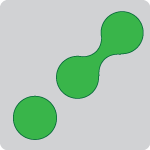PDB Component Library
The PDB Component Library is a collection of web components for visualization of PDB and related protein structural data.
** Deprecated AngularJS web-components documentation is available here
Visualisations
- PDB Prints
- PDB Topology Viewer
- PDB Ligand Environment (Beta)
- PDBe Molstar
- PDB-REDO
- PDB Residue Interactions
- PDB 3D Complex
- PDB ProtVista
PDB Prints
A PDBprint for a PDB entry is a collection of PDBlogos displayed in a specific order, where each icon represents a well-defined category of information.
In PDBprints following categories are included:
- Primary citation: has the PDB entry been published?
- Taxonomy: what is the source organism of the biomacromolecule(s) in the entry?
- Sample-production technique: how was the sample of the biomacromolecule(s) obtained?
- Structure-determination method: which experimental technique(s) was used to determine the structure and was the experimental data deposited?
- Protein content: does the entry contain any protein molecules?
- Nucleic acid content: does the entry contain any nucleic acid molecules (DNA, RNA or a hybrid)?
- Heterogen content: does the entry contain any ligands (such as inhibitors, cofactors, ions, metals, etc.)?
Resources
Source code: GitHubDocumentation and working examples: GitHub Wiki
<pdb-prints entry-id="1cbs"></pdb-prints>Refer here for details of all the available attributes
PDB Topology Viewer
The topology viewer depicts the secondary structure of a protein in a 2D representation, taking into account the interactions of these secondary structure elements. This leads to a consistent display of sheets and domains in the structure. For PDB entries with multiple copies of a protein, the best chain is used. The topology viewer also depicts value-added annotation from SIFTS including residue-level mapping to UniProt, sequence families (Pfam), structure domains (SCOP, CATH) and structure quality from wwPDB validation reports.
Resources
Source code: GitHubDocumentation and working examples: GitHub Wiki
<pdb-topology-viewer entry-id="1cbs" entity-id="1"></pdb-topology-viewer>Refer here for details of all the available attributes
PDB Ligand Environment (Beta)
This is a web-component to display ligand structure in 2D along with its interactions. Ligand can be perceived as a set of covalently linked pdb residues (refered to as bound molecule) or a single pdb residue. This depiction can be enriched with a substructure highlight and binding site interactions.
Resources
Source code & Documentation: GitLab<pdb-ligand-env pdb-id="1cbs" pdb-res-id="200" pdb-chain-id="A"></pdb-ligand-env>PDBe Molstar
PDBe Molstar is a streamlined structure viewer which enables a PDB structure to be explored within a browser rather than requiring pre-installed molecular graphics software. Navigation is simple, with rotation of the camera using the left mouse button, zooming controlled with the right mouse button and clicking on a residue or atom to center the view to this point. There is also the option to view electron density of the structure where structure factors have been deposited to the PDB. PDBe Molstar also displays validation and domain information for the structure.
This is a PDBe implementation of Molstar project.
Collaborations



Resources
Source code: GitHubDocumentation and working examples: GitHub Wiki
<pdbe-molstar molecule-id="1cbs" hide-controls="true"></pdbe-molstar>Refer here for details of all the available attributes
PDB-REDO
The PDB-REDO component shows the change in geometric quality (a combined score for Ramachandran plot, side-chain rotamer, and atomic packing quality) and fit to the experimental data between original PDB entry and its re-refined and rebuilt PDB-REDO counterpart.
Collaborations


Resources
Source code: GitHubDocumentation and working examples: GitHub Wiki
<pdb-redo pdb-id="1cbs"></pdbe-redo>PDB Residue Interactions
This is a component based on the residue contacts viewer in Protein Contacts Atlas. It displays, in graphical form, the atomic contacts between each of the secondary structural elements (helices and sheets) in a protein. The broader the connection between each of the secondary structural elements, the more atomic contacts are involved in the interface. Hovering over these connections will display the exact number of atomic contacts in this interaction.
Collaborations


Resources
Source code: GitHubDocumentation and working examples: GitHub Wiki
<pdb-residue-interactions pdb-id="1cbs" chain-id="A"></pdb-residue-interactions>PDB 3D Complex
The PDB 3D complex is a server that analyses the complexes in crystal structures. This component gives a compact summary of the results for a particular PDB code and assembly. Selecting ‘more details’ gives further information based on the 3D Complex prediction and clicking on the ‘Evidence’ text links out to the server for further information.
Collaborations


Resources
Source code: GitHubDocumentation and working examples: GitHub Wiki
<pdb-3d-complex pdb-id="1lec" assembly-id="1"></pdb-3d-complex>PDB ProtVista
PDB ProtVista view shows a linear representation of the sequence of the protein and depicts value-added annotation from different resources.
It is a PDBe implementation of EBI Nightingale visualisation web components
Collaborations



Resources
Source code: GitHubDocumentation and working examples: GitHub Wiki
<protvista-pdb accession="P05067"></protvista-pdb>Refer here for details of all the available attributes
